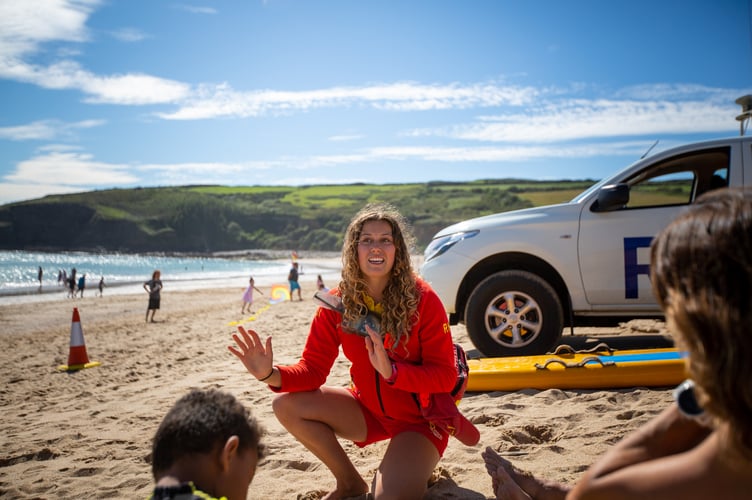With temperatures well above 20°C all week and into the weekend, Steve Instance, RNLI Water Safety Lead in the south west said: ‘With the warm weather forecast this week, we want to remind everyone to stay safe when visiting the coast.
‘As the peak season finishes for RNLI lifeguards and with this a reduction of lifeguarded beaches, we’re asking people to continue to take care and be aware of the dangers.
‘Whilst the number of lifeguarded beaches has reduced there are still plenty of beaches with lifeguard cover around our region.
‘If you are planning on swimming or bodyboarding at a lifeguarded beach, always swim between the red and yellow flags as this is the safest area and is most closely monitored by lifeguards.
‘If you get into trouble in the water or find yourself caught in a rip current remember Float to Live. Tilt your head back with your ears submerged and try to relax and control your breathing. Use your hands to help you stay afloat and then call for help or swim to safety if you can.’
Although people should be thinking about water safety at every beach they visit, different beaches can have different hazards. It’s important to be aware of the local risks at the beach you’re visiting and always read the beach safety signage.
Crantock Beach near Newquay, Cornwall, has a number of local hazards unique to the beach. As well as the meandering river that causes a strong rip current at certain states of tide, the beach has an ongoing issue with tall, sheer, unstable sand cliffs.
RNLI Lead Lifeguard Supervisor for Newquay, Lewis Timson, said:
‘The sand dunes at Crantock are an ongoing situation the lifeguards have had to manage all summer. We have safety signage in place and lifeguards will continue daily patrols until Sunday 24 September.
‘But with the recent big spring tides the sand dunes have become very unstable again and they could collapse at any moment, with the risk of trapping people underneath.’
Rescuing someone trapped under sand requires a special technique that involves multiple people forming a human chain to move the heavy sand away from the casualty as they are freed – to prevent it re-collapsing.
Although RNLI lifeguards participate in multi-agency sand collapse training, they are very difficult rescue operations and extremely time critical. Lewis continued:
‘Our advice to the public is to keep at least 50m (164ft) away from the base of the sand dunes. If you witness a collapse, call 999 and ask for the Coastguard and fire service. Please do not put yourself in danger and attempt to rescue.
‘We’ve been working with the fire service and National Trust to produce flyers with specific safety messages that are being given out to the public on entry to the local car parks. And our lifeguards are always happy to offer safety advice and answer any questions you may have.’
Steve Instance summarised by saying:
‘We want people to enjoy the beautiful coast our region has to offer when the sun is shining, but we ask that you think about your safety as well as the safety of your family and friends, so you can remember your time on the beach for all the right reasons.’
RNLI lifeguards will still be on some south west beaches until the end of September (with additional cover during the October half-term). To find your nearest RNLI lifeguarded beach and check its season dates, click here.
RNLI Float to live advice:
- Tilt your head back with ears submerged
- Relax and try to control your breathing
- Move your hands to help you stay afloat
- Once you are over the initial shock, call for help or swim to safety
- In an emergency call 999 or 112 – if you are at sea or on the beach ask for the Coastguard.

-and-Sally-Ann-(visitor-experience-officer)-trying-ou.jpeg?width=209&height=140&crop=209:145,smart&quality=75)


.jpeg?width=209&height=140&crop=209:145,smart&quality=75)
Comments
This article has no comments yet. Be the first to leave a comment.